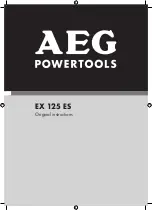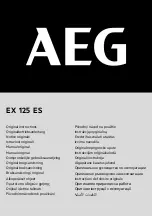
Page of 9
6
coarse or very coarse grit and sand with the grain. On very uneven surfaces or hardwood, sand
across the grain. Be careful to avoid gouging. Then switch to a medium grit belt and sand with the
grain. This will provide a relatively level and smooth finish. Now insert a fine grit belt for final
finishing. Always sand with the grain to remove scratches left by coarser belts. Keep the Mini Belt
Sander moving in long, light strokes during finishing operations. As a final touch, experienced
sanders will often insert a “used” fine belt to provide a smooth surface for filling, sealing, brushing or
spraying.
Sanding Coated Timber
Your Mini Belt Sander will also help remove old paint, varnish or lacquer. However, if the coating
consists of several layers, remove as much as possible with a paint or varnish remover before using
the Mini Belt Sander. Use a hand scraper to remove the residue left by the solvent and allow the
surface to dry completely before sanding.
Precautions to take when sanding paint
Sanding of lead based paint is NOT RECOMMENDED due to the dangers of lead poisoning. Kits
are available to test if the paint is lead based. It is recommended that a dust mask is worn at all
times during sanding operations. The fitting of a dust bag will only reduce dust particles.
Environmental safety
• Paint should be removed in such a manner so as to minimize the amount of dust generated.
• Areas where paint removal is occurring should be sealed with plastic sheeting.
• Sanding should be done in a manner to reduce tracking of paint dust outside the work area.
Cleaning and disposal
• All surfaces in the work area should be vacuumed and thoroughly cleaned daily for the duration of
the sanding project. Vacuum filter bags should be changed frequently.
• Plastic drop sheets should be gathered up and disposed of along with any dust, wood chips or
other removal debris. They should be placed in sealed plastic bags and disposed of through
regular garbage pick-up procedures.
• During clean up, children, pets and pregnant women should be kept away from the immediate
work area.
MAINTENANCE
• Maintain your Mini Belt Sander.
It is recommended that the general condition of any Mini Belt
Sander be examined before it is used. Keep your Mini Belt Sander in good repair by adopting a
program of conscientious repair and maintenance. Have necessary repairs made by qualified
service personnel.
•
Keep the ventilation slots of the Mini Belt Sander clean at all times and prevent any foreign
matter from entering.
•
If the housing of the Mini Belt Sander requires cleaning, do not use solvents but a moist soft
cloth only. Never let any liquid get inside the tool. Never immerse any part of the tool into a liquid.
•
After each use blow air through the Mini Belt Sander to ensure it is free from all dust particles
that may build up. Build up of dust particles may cause the tool to overheat and fail.
•
When the carbon brushes wear out, the tool will stop. The brushes should be replaced prior to
wearing out fully. Brushes will wear out after many uses but before they do, take the tool to a
power tool repairer for a quick and low cost replacement.
Содержание 30092
Страница 7: ...Page of 9 7 DIAGRAM PARTS LIST...



























